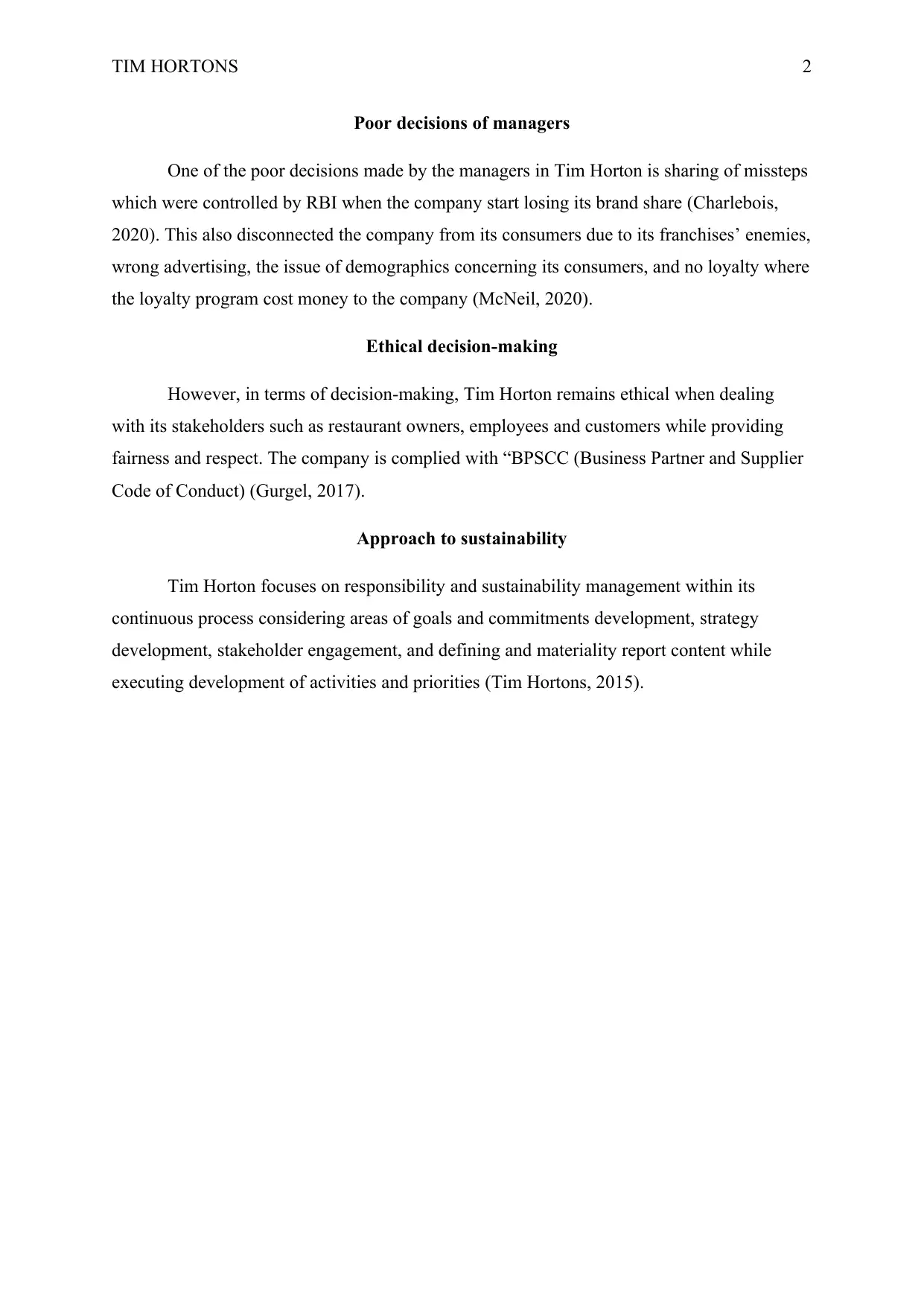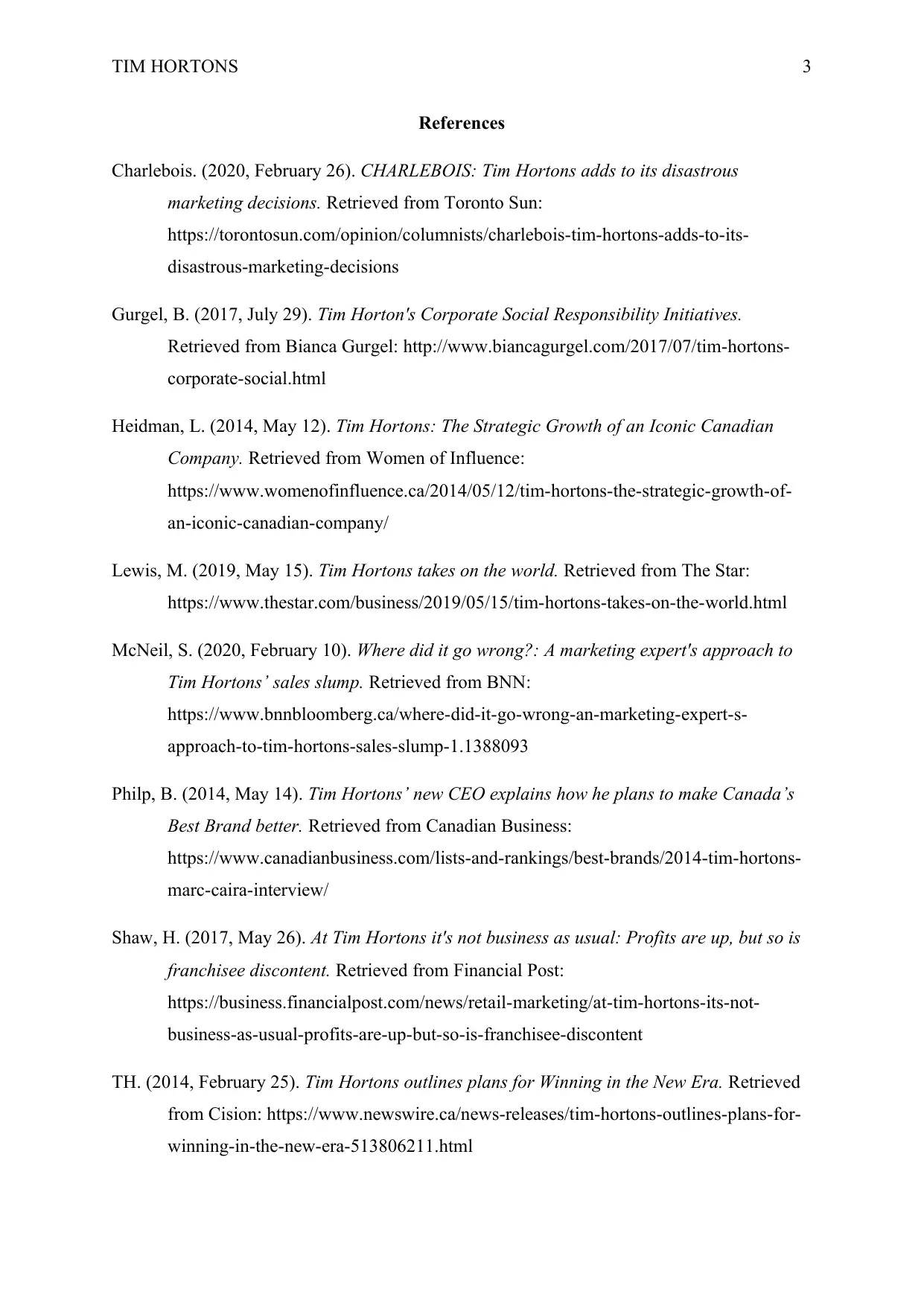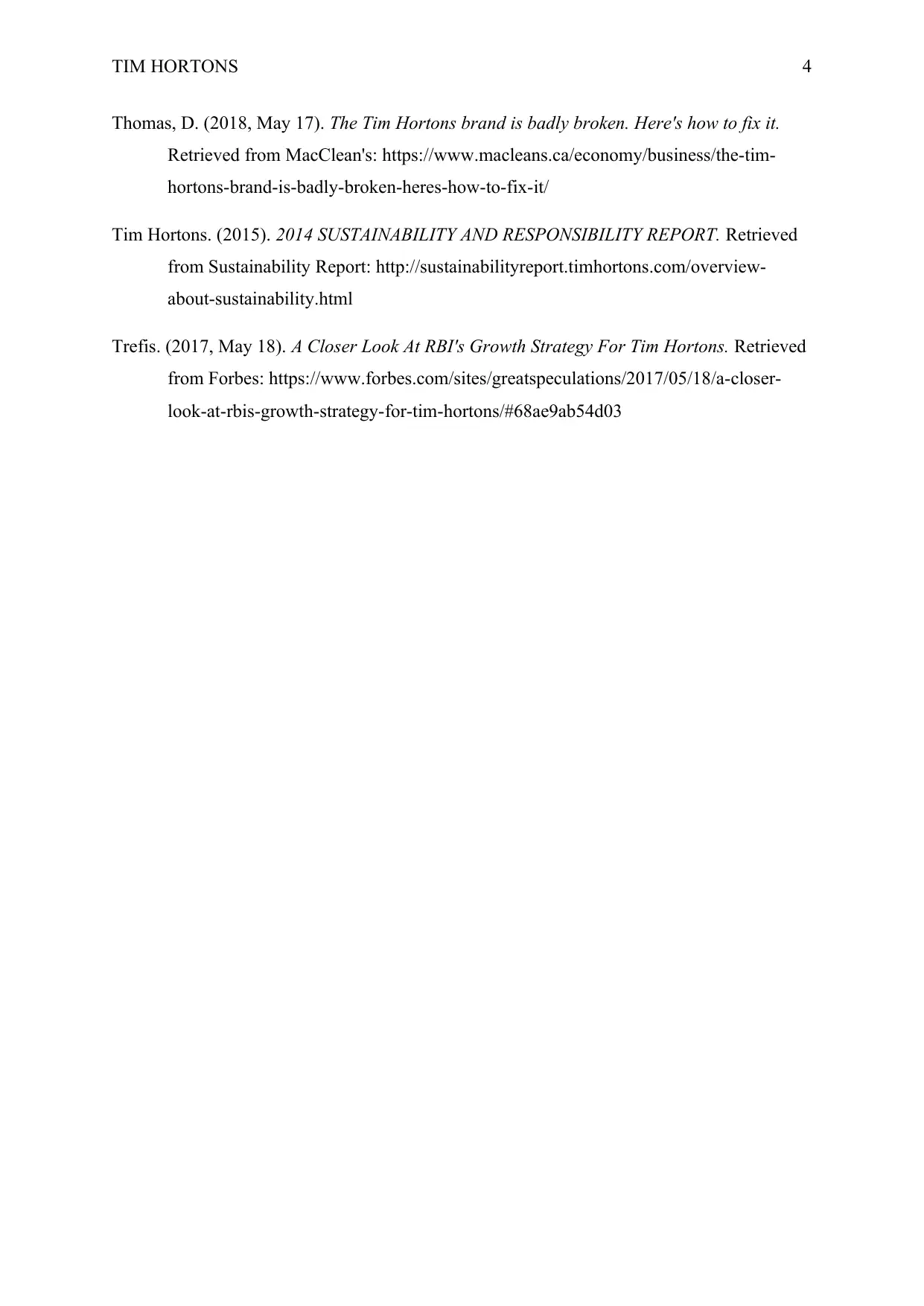Principles of Management: Tim Hortons Corporate Strategy Analysis
VerifiedAdded on 2022/09/17
|5
|885
|34
Report
AI Summary
This report examines Tim Hortons' corporate-level strategy, focusing on its expansion efforts in the United States and globally, and its emphasis on market capital and human resources. The business-level strategy is identified as primarily cost-leadership, with elements of differentiation. The report analyzes how Tim Hortons' vision and mission are supported by its strategies, including product innovation and brand management. It discusses the company's strategic shifts towards environmental conservation and community building, and its successful planning process in Canada, while also pointing out poor management decisions, such as those related to franchise relations and marketing. The report concludes by highlighting Tim Hortons' ethical decision-making and its approach to sustainability, focusing on stakeholder engagement and responsibility management.

Running Head: TIM HORTONS 0
Principles of
Management
Student Details:
Principles of
Management
Student Details:
Paraphrase This Document
Need a fresh take? Get an instant paraphrase of this document with our AI Paraphraser

TIM HORTONS 1
Corporate-level strategy
Tim Horton’s corporate level strategy aims at maximising growth majorly in the
United States (US) and across the globe as well. The company focuses on market capital and
investing in human resource (TH, 2014).
Business-level strategy
Tim Horton’s business level strategy is cost-leadership strategy where the company
focuses on creating value by costs reduction, capturing market share and maintains its
customer base by providing low prices; however, at some level, the company pursue
differentiation strategy as well (Trefis, 2017).
Strategies supporting vision and mission
Tim Horton’s vision is to “be the quality leader” across the globe where cost
leadership strategy does not support this but makes sure to provide values to customers as per
its mission of delivering superior quality products and services through differentiation
strategy considering product innovation, quality management, and brand management which
increases their willingness to buy (Heidman, 2014).
Shift in strategy
The company involved in activities for making changes to treat customers is better
way and contributing actively in the environment conservation by empowering individuals
and capacity communities building (Shaw, 2017). Tim Horton always thought of making
difference in a true sense in relation to the wining together spirit while maintaining stability
and creative a supportive culture. This shows the shift in strategies in terms of expansion and
integration, and functional-level strategy as well for effectiveness in operations; also
enhancing differentiation strategy (Philp, 2014).
Successful planning process
Tim Horton’s has a successful planning process for identifying the best possible
sources for attaining competitive advantage by performing primary and secondary activities
of value chain (Lewis, 2019). The company holds a strong market in Canada through
development process of its brand image across the globe but fail to expand globally. Hence,
its strategy is a reason of the company’s success (Thomas, 2018).
Corporate-level strategy
Tim Horton’s corporate level strategy aims at maximising growth majorly in the
United States (US) and across the globe as well. The company focuses on market capital and
investing in human resource (TH, 2014).
Business-level strategy
Tim Horton’s business level strategy is cost-leadership strategy where the company
focuses on creating value by costs reduction, capturing market share and maintains its
customer base by providing low prices; however, at some level, the company pursue
differentiation strategy as well (Trefis, 2017).
Strategies supporting vision and mission
Tim Horton’s vision is to “be the quality leader” across the globe where cost
leadership strategy does not support this but makes sure to provide values to customers as per
its mission of delivering superior quality products and services through differentiation
strategy considering product innovation, quality management, and brand management which
increases their willingness to buy (Heidman, 2014).
Shift in strategy
The company involved in activities for making changes to treat customers is better
way and contributing actively in the environment conservation by empowering individuals
and capacity communities building (Shaw, 2017). Tim Horton always thought of making
difference in a true sense in relation to the wining together spirit while maintaining stability
and creative a supportive culture. This shows the shift in strategies in terms of expansion and
integration, and functional-level strategy as well for effectiveness in operations; also
enhancing differentiation strategy (Philp, 2014).
Successful planning process
Tim Horton’s has a successful planning process for identifying the best possible
sources for attaining competitive advantage by performing primary and secondary activities
of value chain (Lewis, 2019). The company holds a strong market in Canada through
development process of its brand image across the globe but fail to expand globally. Hence,
its strategy is a reason of the company’s success (Thomas, 2018).

TIM HORTONS 2
Poor decisions of managers
One of the poor decisions made by the managers in Tim Horton is sharing of missteps
which were controlled by RBI when the company start losing its brand share (Charlebois,
2020). This also disconnected the company from its consumers due to its franchises’ enemies,
wrong advertising, the issue of demographics concerning its consumers, and no loyalty where
the loyalty program cost money to the company (McNeil, 2020).
Ethical decision-making
However, in terms of decision-making, Tim Horton remains ethical when dealing
with its stakeholders such as restaurant owners, employees and customers while providing
fairness and respect. The company is complied with “BPSCC (Business Partner and Supplier
Code of Conduct) (Gurgel, 2017).
Approach to sustainability
Tim Horton focuses on responsibility and sustainability management within its
continuous process considering areas of goals and commitments development, strategy
development, stakeholder engagement, and defining and materiality report content while
executing development of activities and priorities (Tim Hortons, 2015).
Poor decisions of managers
One of the poor decisions made by the managers in Tim Horton is sharing of missteps
which were controlled by RBI when the company start losing its brand share (Charlebois,
2020). This also disconnected the company from its consumers due to its franchises’ enemies,
wrong advertising, the issue of demographics concerning its consumers, and no loyalty where
the loyalty program cost money to the company (McNeil, 2020).
Ethical decision-making
However, in terms of decision-making, Tim Horton remains ethical when dealing
with its stakeholders such as restaurant owners, employees and customers while providing
fairness and respect. The company is complied with “BPSCC (Business Partner and Supplier
Code of Conduct) (Gurgel, 2017).
Approach to sustainability
Tim Horton focuses on responsibility and sustainability management within its
continuous process considering areas of goals and commitments development, strategy
development, stakeholder engagement, and defining and materiality report content while
executing development of activities and priorities (Tim Hortons, 2015).
⊘ This is a preview!⊘
Do you want full access?
Subscribe today to unlock all pages.

Trusted by 1+ million students worldwide

TIM HORTONS 3
References
Charlebois. (2020, February 26). CHARLEBOIS: Tim Hortons adds to its disastrous
marketing decisions. Retrieved from Toronto Sun:
https://torontosun.com/opinion/columnists/charlebois-tim-hortons-adds-to-its-
disastrous-marketing-decisions
Gurgel, B. (2017, July 29). Tim Horton's Corporate Social Responsibility Initiatives.
Retrieved from Bianca Gurgel: http://www.biancagurgel.com/2017/07/tim-hortons-
corporate-social.html
Heidman, L. (2014, May 12). Tim Hortons: The Strategic Growth of an Iconic Canadian
Company. Retrieved from Women of Influence:
https://www.womenofinfluence.ca/2014/05/12/tim-hortons-the-strategic-growth-of-
an-iconic-canadian-company/
Lewis, M. (2019, May 15). Tim Hortons takes on the world. Retrieved from The Star:
https://www.thestar.com/business/2019/05/15/tim-hortons-takes-on-the-world.html
McNeil, S. (2020, February 10). Where did it go wrong?: A marketing expert's approach to
Tim Hortons’ sales slump. Retrieved from BNN:
https://www.bnnbloomberg.ca/where-did-it-go-wrong-an-marketing-expert-s-
approach-to-tim-hortons-sales-slump-1.1388093
Philp, B. (2014, May 14). Tim Hortons’ new CEO explains how he plans to make Canada’s
Best Brand better. Retrieved from Canadian Business:
https://www.canadianbusiness.com/lists-and-rankings/best-brands/2014-tim-hortons-
marc-caira-interview/
Shaw, H. (2017, May 26). At Tim Hortons it's not business as usual: Profits are up, but so is
franchisee discontent. Retrieved from Financial Post:
https://business.financialpost.com/news/retail-marketing/at-tim-hortons-its-not-
business-as-usual-profits-are-up-but-so-is-franchisee-discontent
TH. (2014, February 25). Tim Hortons outlines plans for Winning in the New Era. Retrieved
from Cision: https://www.newswire.ca/news-releases/tim-hortons-outlines-plans-for-
winning-in-the-new-era-513806211.html
References
Charlebois. (2020, February 26). CHARLEBOIS: Tim Hortons adds to its disastrous
marketing decisions. Retrieved from Toronto Sun:
https://torontosun.com/opinion/columnists/charlebois-tim-hortons-adds-to-its-
disastrous-marketing-decisions
Gurgel, B. (2017, July 29). Tim Horton's Corporate Social Responsibility Initiatives.
Retrieved from Bianca Gurgel: http://www.biancagurgel.com/2017/07/tim-hortons-
corporate-social.html
Heidman, L. (2014, May 12). Tim Hortons: The Strategic Growth of an Iconic Canadian
Company. Retrieved from Women of Influence:
https://www.womenofinfluence.ca/2014/05/12/tim-hortons-the-strategic-growth-of-
an-iconic-canadian-company/
Lewis, M. (2019, May 15). Tim Hortons takes on the world. Retrieved from The Star:
https://www.thestar.com/business/2019/05/15/tim-hortons-takes-on-the-world.html
McNeil, S. (2020, February 10). Where did it go wrong?: A marketing expert's approach to
Tim Hortons’ sales slump. Retrieved from BNN:
https://www.bnnbloomberg.ca/where-did-it-go-wrong-an-marketing-expert-s-
approach-to-tim-hortons-sales-slump-1.1388093
Philp, B. (2014, May 14). Tim Hortons’ new CEO explains how he plans to make Canada’s
Best Brand better. Retrieved from Canadian Business:
https://www.canadianbusiness.com/lists-and-rankings/best-brands/2014-tim-hortons-
marc-caira-interview/
Shaw, H. (2017, May 26). At Tim Hortons it's not business as usual: Profits are up, but so is
franchisee discontent. Retrieved from Financial Post:
https://business.financialpost.com/news/retail-marketing/at-tim-hortons-its-not-
business-as-usual-profits-are-up-but-so-is-franchisee-discontent
TH. (2014, February 25). Tim Hortons outlines plans for Winning in the New Era. Retrieved
from Cision: https://www.newswire.ca/news-releases/tim-hortons-outlines-plans-for-
winning-in-the-new-era-513806211.html
Paraphrase This Document
Need a fresh take? Get an instant paraphrase of this document with our AI Paraphraser

TIM HORTONS 4
Thomas, D. (2018, May 17). The Tim Hortons brand is badly broken. Here's how to fix it.
Retrieved from MacClean's: https://www.macleans.ca/economy/business/the-tim-
hortons-brand-is-badly-broken-heres-how-to-fix-it/
Tim Hortons. (2015). 2014 SUSTAINABILITY AND RESPONSIBILITY REPORT. Retrieved
from Sustainability Report: http://sustainabilityreport.timhortons.com/overview-
about-sustainability.html
Trefis. (2017, May 18). A Closer Look At RBI's Growth Strategy For Tim Hortons. Retrieved
from Forbes: https://www.forbes.com/sites/greatspeculations/2017/05/18/a-closer-
look-at-rbis-growth-strategy-for-tim-hortons/#68ae9ab54d03
Thomas, D. (2018, May 17). The Tim Hortons brand is badly broken. Here's how to fix it.
Retrieved from MacClean's: https://www.macleans.ca/economy/business/the-tim-
hortons-brand-is-badly-broken-heres-how-to-fix-it/
Tim Hortons. (2015). 2014 SUSTAINABILITY AND RESPONSIBILITY REPORT. Retrieved
from Sustainability Report: http://sustainabilityreport.timhortons.com/overview-
about-sustainability.html
Trefis. (2017, May 18). A Closer Look At RBI's Growth Strategy For Tim Hortons. Retrieved
from Forbes: https://www.forbes.com/sites/greatspeculations/2017/05/18/a-closer-
look-at-rbis-growth-strategy-for-tim-hortons/#68ae9ab54d03
1 out of 5
Related Documents
Your All-in-One AI-Powered Toolkit for Academic Success.
+13062052269
info@desklib.com
Available 24*7 on WhatsApp / Email
![[object Object]](/_next/static/media/star-bottom.7253800d.svg)
Unlock your academic potential
Copyright © 2020–2025 A2Z Services. All Rights Reserved. Developed and managed by ZUCOL.





